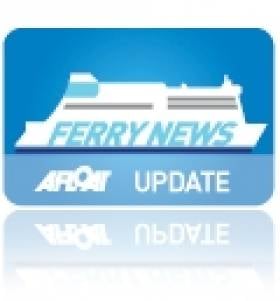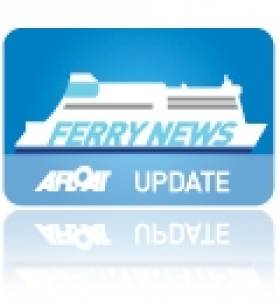Displaying items by tag: St. David
Second Stena ‘Superfast’ Ferry is Underway from Poland
The new route to Loch Ryan Port, Cairnryan includes a new £80m ferryport terminal which will be served by the 30,000 gross tonnes sisters, the largest ever ferries on the North Channel. Stena Superfast VIII is currently in the Skagerrak off northern Denmark and follows her sister Stena Superfast VII which arrived over the weekend, having also undergone refurbishment at the Romentowa shipyard.
The relocation of Scottish terminal from Stranraer to Loch Ryan Port is seven miles closer to the open sea and sailing times are to be reduced to 2hrs and 15minutes. The new terminal is to be officially opened on 25th November when First Minister of Scotland Alex Salmond and Deputy First Minister of Northern Ireland Martin McGuinness will join Dan Sten Olsson, Chairman of Stena Line.
As for the 15,229 gross tonnes Stena Navigator, she made her Stranraer-Belfast sailing yesterday, after de-storing at the VT4 ferry terminal, only completed in 2008, she proceeded to berth at Albert Quay, the location of the former city-centre ferry terminal.
In the interim period to the opening of the new Belfast-Cairnryan route, the sailing schedule on the Belfast-Stranraer service are been maintained by another conventional ferry, Stena Caledonia and fast sailings by the HSS Stena Voyager.
HSS Stena Voyager is expected to lay-up at VT4 after making final sailings to and from Stranraer this Sunday. It is expected Stena Caledonia will also be withdrawn that day and berth at Albert Quay. In the process she will pass Harland & Wolf shipyard, where she was launched in 1981 as the St. David, the last of the quartet of Saint-class ferries commissioend for Sealink/British Rail.
The career of Stena Navigator on the North Channel was short as she only entered service two years ago. She was built in 1984 as Champs Elysees first served for SNCF/Sealink's jointly run Dover-Calais route, followed by a brief spell under Stena Line as Stena Parisien on Newhaven-Dieppe sailings.
She returned to the Straits of Dover route but this time as SeaFrance Manet under the control of SeaFrance. In 2008 SeaFrance introduced SeaFrance Moliere, the former Superfast X, ironically another sister of Stena Line's 'Superfast' ships. This Superfast vessel along with two custom built newbuilds entered SeaFrance service in recent years which led to the eventual replacement of SeaFrance Renoir and her half sister SeaFrance Manet.
- Port of Belfast
- Stena Line
- Ports and Shipping News
- Ferry news
- Loch Ryan Port
- HSS Stena Voyager
- St. David
- SeaFrance
- DoverCalais
- Belfast Lough News
- Sealink
- H&W
- BelfastCairnryan
- Stena Superfast sisters
- Loch Ryan Port Cairnryan
- Romentowa
- Harland & Wolf
- Sealink/British Rail
- SaintClass sisters
- SNCF
- Straits of Dover
- Attica
- VT4 Terminal
- Loch Ryan Scotland
- Sealink British Rail
Superfast Sisterships for Stena's Northern Route
Stena will lease the ferries for a three year period from Tallink, the Baltic Sea based shipping group. (Click here for photo of Superfast VIII in ice-flow waters). The charter arrangement includes an option to extend for a further year.
The distance between the new ferry terminal named the 'Loch Ryan Port' at Old House Point (which is just north of Cairnryan) is approx. 8kms apart from Stranraer taking the coastal (A77) road along the Loch that leads onto to Glasgow. At Cairnryan, rivals P&O (Irish Sea) who along with predecessing operators have run services on the route to Larne for several decades.
With a speed of 27-knots, passage times on the new Stena Belfast-Cairnryan route will take 2 hours 15 minutes, this compares to the existing time of 2 hours 50 minutes from Stranraer by conventional ferry and 2 hours taken by the HSS fast-ferry.
As a consequence of Stena operating from Loch Ryan Port, passage times by the Superfast sisters will be reduced by 35 minutes as the Belfast terminal was also relocated in recent years. Though despite the relocated ferry terminals, the Superfast sisters scheduled 2 hours 15 minutes sailings from the new port will be slightly longer compared to the HSS Stena Voyager's 2 hour sailing time from Stranraer.
Also serving the Belfast Stranraer route are the conventional ferries, Stena Caledonia (formerly Sealink's St. David built at Harland & Wolff) and Stena Navigator, that served SeaFrance on Dover-Calais sailings as SeaFrance Manet. When the Superfast sisters replace the HSS Stena Explorer and the conventional ferries, perhaps there will be a new a role for the two vessels in replacing expensive to run fast-craft operated elsewhere.
In the meantime the Superfast pair will maintain running on Tallink's 26-hour Helsinki-Rostock until mid-August. The 2001 German will then undergo an extensive refit of passenger facilities and a new freight-only deck will be incorporated to cater for haulage operators increasing use of higher vehicles and double-deck freight units.
The 'Superfast' vessel naming theme derives from the original owners, Greek operator Superfast Ferries, which sold their Scandinavian operations to Tallink in 2006.






























































